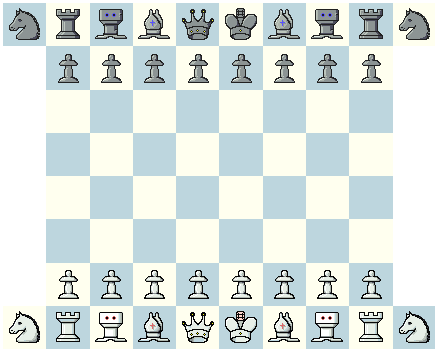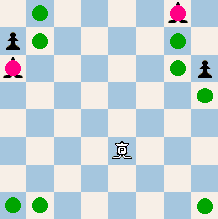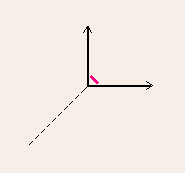

The Provocator is a bifurcation piece. The Provocator moves by colliding diagonally against any piece, and then deviating to any of the two adjacent orthogonals (in the prolonged movement direction). It captures on the second leg only. The Provocator can also move by colliding against the margin, whereby only one movement direction is available after collision. Without screens to collide against the Provocator cannot move. The Provocator's value is the same as a knight or bishop (my estimate). Other rules are the same as in standard chess, except for the possible promotion to Provocator. As it can move only by coordinating with another piece, the Provocator is a highly cooperative piece, something which makes it interesting to the positional player. The structure on the board decides its possibilities. The Provocator has the interesting capacity of zigzaging between the pieces in the middlegame. It loses less power in the endgame than one would expect. Although screens for colliding become fewer, its scope and mobility also increases. The Provocator's capacity to collide with the margin is an important capacity. Provocator Chess can also be played with Kwaggas instead of knights (see Bodyguard Chess). Provocator Chess, and the new Provocator piece, were invented by undersigned, February 2007.
Provocator : the only gladiator type in ancient Rome allowed to wear a breastplate (cardiophylax). He also carried helmet, a gladius (short sword), and a long, rectangular, shield.
 The Provocator moves in two legs, the first is a bishop slide and the second is an orthogonal collision-move. Both movement and capture occur on the second leg (red = capture).
The Provocator moves in two legs, the first is a bishop slide and the second is an orthogonal collision-move. Both movement and capture occur on the second leg (red = capture).
 The Provocator's movement principle. The screens, that are used for colliding, occur anywhere on the first leg.
The Provocator's movement principle. The screens, that are used for colliding, occur anywhere on the first leg.
• You can download my free Provocator Chess program here (updated 2007-02-08), but you must own the software Zillions of Games to be able to run it (I recommend the download version).
• Don't miss my other chess variants.
© M. Winther (February 2007).